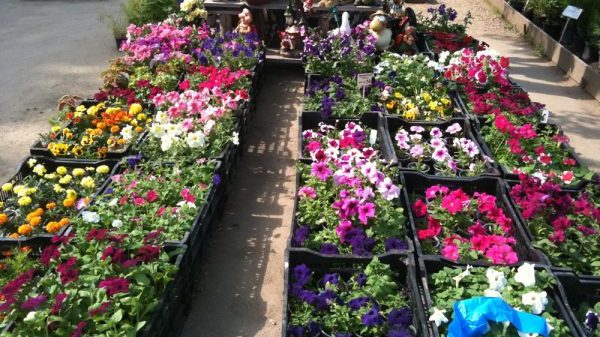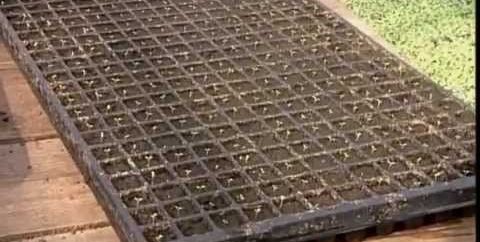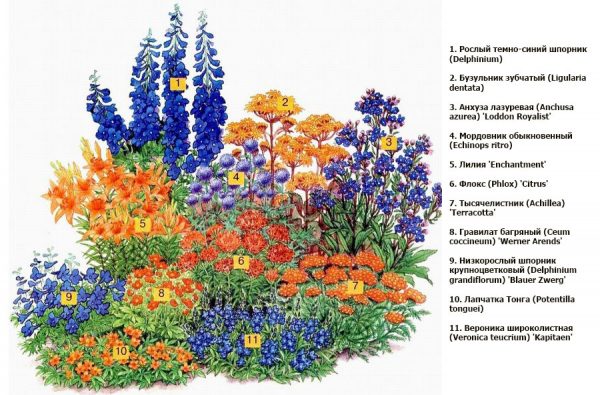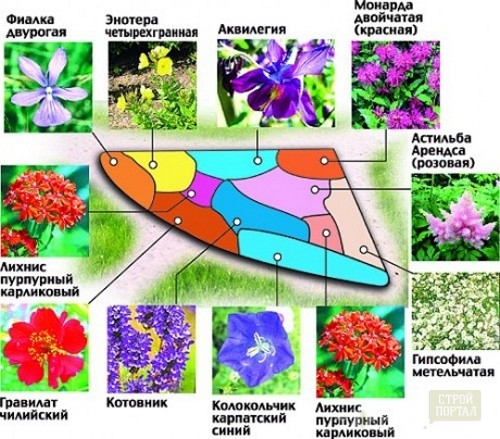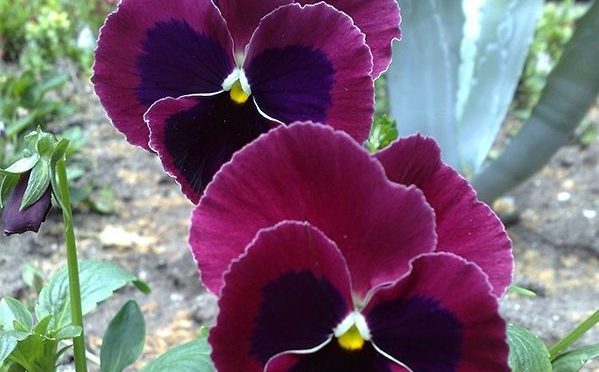Varieties and planting of annual flowers for summer cottages
Content
How to choose plants
Annuals can be an addition to perennial or non-flowering ornamental plants, or you can make a flower bed only from them. The main thing is to think carefully about what types of flowers will be needed, then draw up a flower garden scheme, decide where the undersized ones will grow, where are tall or curly annuals, and only after that select the seeds of annual flowers. If you do not want to mess with the seeds, you can immediately buy seedlings, you can even buy annual blooming flowers, immediately place them on the garden bed. Some flowers, such as calendula, are sown by themselves, and the next year they grow beautifully from seeds.
Of course, they need care, fertilization and watering, but unlike perennials, they will not have to be treated, saved from pests, or sheltered for the winter. All summer they will bloom, they will give seeds in autumn, and their greenery will become fertilizer for the garden. Some zealous owners sow them as siderates - they decorate the dacha, then fertilize the soil. This happens with the same calendula, if it settles in the garden.
It is undesirable to buy seeds or seedlings of any flowering species of flowers, knowing only the names of them. Lit is better to draw up a diagram of the flower bed in advance, arranging the plants by color, growth. To choose the right flowers for a flower bed, you need to know the timing of flowering. As a rule, all annuals are long-flowering, but some bloom in early summer, and others closer to autumn, some stop blooming in August, while others, like calendula, continue until frost. Knowing the timing of flowering, you can make a flower bed in such a way that it will delight you with colorful flowers all season - the plants will bloom in turn.
The selection of plants depends on the location of the flower garden. For flower beds in the middle of the yard, undersized (very often it is a viola) and medium are suitable, and tall or curly, often shade-loving, are planted near fences or walls. Curly flowers can help disguise an unsightly structure or an old fence, can create beautiful gazebos or a light shadow over a bench. Matching by color is of great importance. Colorful flower beds in a rustic style look beautiful. Flower beds, which are formed from flowers of different types, but of the same color: white, pink, yellow, orange, look more decorative.
Video "Reproduction and planting of one-year-olds"
Demonstration video with examples and an algorithm of actions.
What flower beds to do
When making a bed of perennial plants, we still have to supplement it with annuals to fill in the voids. But you can bother and build a flower garden only from annual plants. They are usually made of modular options, ridges, mixborders, color spots, single plantings (or group).
It is very convenient to plant flowers in flowerpots or containers - they can be placed along the paths, by the pool or pond, on the balcony or on the doorstep. In this case, it is very easy to change the flower arrangement - you do not need to dig out and replant, but simply transfer it from place to place.Flowers that grow in this way require less attention, they are easier to care for than those growing in the garden. Petunia, fuchsia, viola, lobelia, nasturtium - beautiful cascades are made of these flowers, using several pots along with outdoor vases, it looks very decorative. They are used to decorate balconies and windows.
Creative owners plant flowers not only in special flowerpots, but also use broken dishes, old shoes (viola looks touching), bedside tables, even cars. You can put a pot somewhere, and some container is simply filled with soil, annual flowers are planted. Such unusual flower beds look very decorative, they can be transferred from place to place, decorating it situationally. You cannot plant a shady corner of the garden with flowers (although there are shade-tolerant, even shade-loving ones), but you can simply bring such modular flower beds for a few hours. This option is good for landscaping a balcony. For modular flower beds that decorate balconies, verandas, thresholds, different varieties of petunias and viola are perfect.
The word "rabatka" is what designers call a motley border, which most often has a regular geometric shape. They are one-sided (in the background of the scheme there are tall plants, and closer to the viewer they are reduced to low-growing viols), two-sided (tall plants are planted in the center, and medium-sized plants on both sides, followed by low-growing ones). Round ridges are created according to the same principle. Calendula, which blooms before frost, is often used.
Mixborder is by far the most popular type of flower garden. It consists of different types of plants that bloom at different times, thus creating the effect of continuous flowering. White, yellow, red, orange, blue, purple flowers can grow side by side and replace each other over time. It is very important to choose plants not only by the timing of flowering and care, but by combinations of color and size. Very often they use yellow or orange calendula, terry asters, viola, matiola - they like to decorate balconies and summer cottages.
Color spots are created from annuals of the same color. A group of yellow calendula or yellow marigolds in the middle of a green lawn looks very decorative. Often bright salvias or zinnia are planted this way. Shade-tolerant viols can hide in the shade of the garden in a small spot in the middle of the grass. A single plant is called a tapeworm, it always becomes the center of the composition. Such plantings are created against the background of a lawn or undersized ground cover plants. Castor oil plant, datura look very decorative.
Group plantings are beneficial in that the plants can take turns drawing their eyes to themselves, the fading becomes invisible to the environment of other flowering ones. Terry asters, salvias of different colors (they are grown as annuals and as biennial flowers), yellow or orange marigolds or marigolds, deciduous and coniferous bushes are also often used here. You can arrange more complex compositions. First, the flower garden is thought out according to the mood, color and shape, they draw up a scheme, then the plants are selected according to it. It is better to make the scheme on paper in order to check with it, already directly organizing the flower bed. It is important not to place light-loving and shade-loving plants nearby.
Overview of annuals
Annuals are:
- undersized;
- medium-sized;
- tall;
Low-growing flowers include flowers, the height of which does not exceed 30 cm. Sometimes they play the role of ground cover when they are planted to fill the space between tall flowers or trimmed shrubs. The most unpretentious, and therefore common, are white airy Iberis, blue nemophila with an amazing smell, unforgettable dwarf viola. Ageratum, expanding, forms incredible pillows of different colors. Yellow and yellow-brown terry marigolds glow with lights from early summer to late autumn. Viola and calendula can act as a border or background.
Tiny daisies and dwarf snapdragons of different colors can become stunted curbs along the paths. They need almost no care, only a little watering and fertilization to replenish their strength for flowering. They are often used to decorate balconies. Among the undersized varieties of silvery cellosia, phlox, groundwort, lobelia, forget-me-nots, there are shade-tolerant specimens, but most need a lot of light.
Medium-sized flowers up to 80 cm high are used for mixed flower beds. The highlight of the site can be balls of verbena flowers, fancy antirrinum, scarlet poppy and lilac salvias. Ease of care and external beauty made yellow escholtia, cosmea, fragrant matiola popular. The seeds of these plants germinate well in the garden, the seedlings are used only if they want an earlier flowering. They are not capricious, shade-tolerant, a little fertilizer and watering, timely weeding is all they need.
Tall annuals reach 1.5 m in height, they are good in single and group planting. Mixborders are supplemented with annual dahlias, amaranth, cochia, ornamental corn and scented tobacco. Snow-white panicles of aruncus and datura bells look exotic. Delphinium, castor oil plant, mallow are very effective in solitaire performance. These flowers grow quickly, many are shade-tolerant, some of them often need support, when planting it is worth considering support. They need watering and fertilization to grow.
Planting and leaving
They say that annual plants need to be cared for. But if you remember the self-sowing asters and calendula, then you can argue with this. Sowing for seedlings is usually done in March, after 2 weeks most of the seeds sprout. Flower seedlings require the same care as vegetable seedlings: they need watering, feeding, heat and light. Therefore, the boxes with sprouts need to be watered on time, placed on a lighted window, turned in different directions to the light source. After the growth of two leaves, the plants dive into separate cups, preferably with fertilizer. The easiest way to care for seedlings is in a greenhouse or greenhouse.
May is the best time to plant flowers in a flower bed. Before that, the place for them already needs to be prepared - to arrange drainage, fertilize, prepare the soil. Caring for flowers in a flower bed is usual - they are watered, the soil is loosened, in some cases mulched, it looks very decorative and protects the plants from weeds and moisture evaporation. Flowers need periodic fertilizing for lush and long flowering. Fading flower stalks, wilted buds need to be removed in time, in many species this stimulates further flowering. For several months of the warm period of the year, annual deciduous and flowering plants go through the entire growing cycle. They can be grown on a flower bed and balcony, the main thing is not to forget about watering and fertilizers.
Video "Rules for planting one-year-olds"
Informative video with recommendations for gardeners who want to make a flower bed from one-year-olds.

